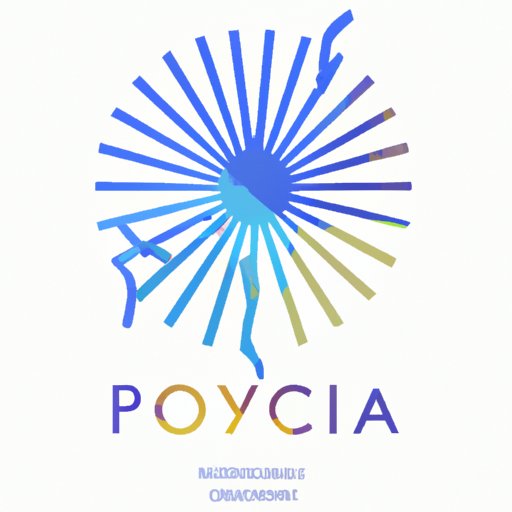
Introduction
Your logo is the visual representation of your brand. It’s the face of your business, the first thing people see when they interact with your brand. As such, it is important that you create a professional logo that accurately reflects your brand’s identity and values.
Creating a professional logo may seem intimidating, but with the right tools and techniques, you can design a logo that effectively communicates your brand message. In this article, we’ll take a look at the seven simple steps to creating a professional logo, along with top design principles, tips, and tricks, and common mistakes to avoid.

7 Simple Steps to Creating a Professional Logo
Step 1: Research and Understand Your Brand and Audience
The first step to creating a professional logo is understanding your brand’s identity and values. This involves researching your target audience, brand mission, and unique selling proposition. By understanding your brand and audience, you can create a logo that resonates with your target market and accurately represents your brand.
Step 2: Choose the Right Design Software
To create a professional logo, you need the right design software. There are a variety of design software options available, from free tools like Canva and GIMP to more advanced software like Adobe Illustrator and Sketch. Choose a tool that best suits your needs and skill level.
Step 3: Sketch Your Ideas and Concepts
Once you have a clear understanding of your brand and audience, start sketching your ideas and concepts on paper. This is an important step in the design process, as it allows you to experiment with different shapes, colors, and typography before moving onto the computer.
Step 4: Experiment with Different Design Elements
Use your chosen design software to experiment with different design elements, such as color, typography, and shape. This is where you can start to bring your sketches to life and create a logo that accurately represents your brand.
Step 5: Refine Your Design
As you work on your design, refine it until you arrive at a logo that accurately represents your brand and resonates with your target audience. This may involve tweaking the color palette, adjusting the typography, or experimenting with different shapes.
Step 6: Get Feedback and Make Revisions
Once you have a design that you’re happy with, get feedback from peers and professionals in your industry. Take their feedback on board and make any necessary revisions to your design.
Step 7: Finalize and Export Your Design
When you’re happy with your design, finalize it and export it in the appropriate file format. This will allow you to use your logo across a variety of platforms, from your website to your social media accounts and beyond.
Top Design Principles for Crafting Effective Logos
When creating a professional logo, it’s important to keep in mind the following design principles:
Simplicity
Simplicity is key when it comes to logo design. A simple logo is more memorable and versatile across different mediums.
Versatility
Your logo should be versatile enough to be used across a variety of platforms, from billboards to business cards and beyond.
Memorability
Your logo should be memorable and resonate with your target audience.
Timelessness
A good logo should stand the test of time and not become outdated easily.
Relevance
Your logo should represent your brand accurately and be relevant to your industry.
Designing a Logo from Scratch: Tips and Tricks to Ensure Success
If you’re designing a logo from scratch, here are some tips and tricks to ensure success:
Start with a Clear Creative Brief
Create a clear creative brief that outlines your brand’s identity, values, and target audience.
Brainstorm with Sketches and Mood Boards
Brainstorm your ideas with sketches and mood boards before moving onto the computer.
Refine Ideas into a Focused Concept
Refine your ideas into a focused concept that accurately represents your brand.
Experiment with Different Color and Typography Variations
Experiment with different color and typography variations to find a combination that works well together.
Get Feedback from Peers and Professionals
Get feedback from peers and professionals in your industry, and make any necessary revisions to your design.
The Importance of Colors in Logo Design and How to Choose Appropriate Ones
Colors play an important role in logo design, as they have the power to communicate emotions and evoke feelings in your audience. Here are some tips for choosing appropriate colors for your brand:
Discuss the Psychological Effects of Different Colors
Different colors have different psychological effects on your audience. For example, red can evoke a sense of excitement or urgency, while blue can evoke a sense of calmness or professionalism.
Provide Tips for Choosing Colors that Align with Brand Values and Messaging
Choose colors that align with your brand’s values and messaging. For example, if you’re a beach resort, you might choose colors that evoke a sense of calmness and relaxation.
Understanding Typography in Logo Design and How to Use it Effectively
Typography also plays an important role in logo design. Here are some tips for using typography effectively:
Discuss the Different Types of Fonts and Their Unique Characteristics
There are a variety of font types available, from serif to sans-serif and beyond. Each type has its own unique characteristics that can convey different emotions and feelings.
Provide Examples of Effective Typography in Logos
Provide examples of effective typography in logos to inspire your own design.
Offer Tips for Pairing Fonts and Using Typography to Convey Brand Messaging
Pair fonts carefully and use typography to convey your brand’s messaging. For example, if you’re a luxury brand, you might choose a serif font that conveys elegance and sophistication.
How to Incorporate Symbolism and Imagery in Your Logo to Communicate Your Brand Message
Symbolism and imagery can also be used to communicate your brand message in your logo. Here are some tips for incorporating symbolism and imagery:
Discuss the Power of Symbolism in Branding
Symbolism can play a powerful role in branding, as it can be used to evoke emotions and convey important messages.
Provide Examples of Logos that Effectively Use Symbolism and Imagery
Provide examples of logos that effectively use symbolism and imagery to inspire your own design.
Offer Tips for Incorporating Symbolism in a Way that Aligns with Brand Messaging
Incorporate symbolism in a way that aligns with your brand messaging and values. For example, if you’re a wellness brand, you might choose imagery that conveys a sense of health and relaxation.
The Dos and Don’ts of Logo Design: Common Mistakes to Avoid and Best Practices to Follow
When it comes to logo design, there are certain dos and don’ts to keep in mind. Here are some common mistakes to avoid and best practices to follow:
Discuss Common Mistakes in Logo Design
Common mistakes in logo design include using too many colors or fonts, copying other designs, and failing to consider your target audience.
Offer Best Practices for Creating Effective Logos
Best practices for creating effective logos include keeping it simple, using appropriate colors and typography, and staying true to your brand’s messaging.
Provide Tips for Avoiding Common Pitfalls
Provide tips for avoiding common pitfalls in logo design, such as failing to do your research, or ignoring peer feedback.
Conclusion
In conclusion, creating a professional logo may seem intimidating, but by following the seven simple steps to logo design, along with top design principles, tips and tricks, and best practices, you can create a logo that effectively communicates your brand message. Remember to keep it simple, use appropriate colors and typography, and stay true to your brand’s values and messaging. With these tips and guidance, you’ll be well on your way to creating a stunning visual identity for your brand.





